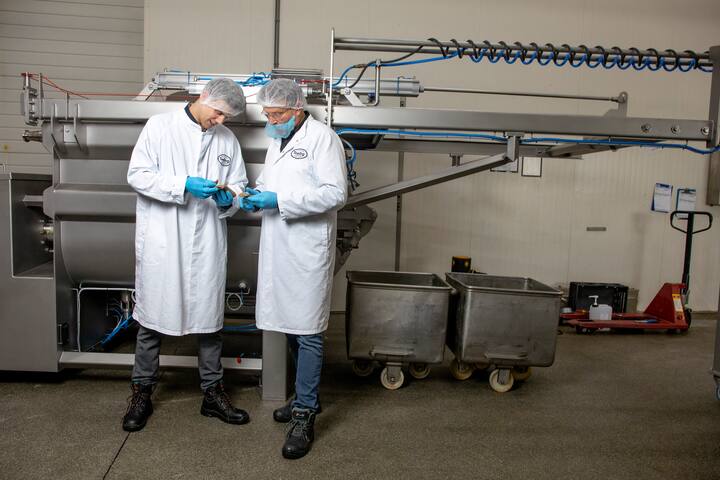
19 May 2025
A monitoring plan helps interpret analysis results
A monitoring plan helps interpret analysis results.
As a manufacturing company, you regularly carry out laboratory and microbiological analyses: sampling of the environment, raw materials, semi-finished products and end products. How do you do this correctly and what are the important things to take into account?
The basis of a monitoring plan
To set up a good monitoring plan, you start with the basics. What are the raw materials and what is the range of end products? Based on this information, you determine which parameters you will investigate.
The basis of the monitoring plan is laid down in various legislation, such as Regulation (EU) 2073/2005, Regulation (EU) 915/2023 and/or Regulation (EU) 1333/2008. For specific hazards, this may also be laid down in other legislation, such as TVB-N in fish species. The standards for this are laid down in Regulation (EU) 2019/627. In addition to European legislation, national legislation and regulations must also be taken into account, such as the Commodities Act Decree on the preparation of foodstuffs in the Netherlands and the Royal Decree of 26 April 2009 on microbiological criteria for foodstuffs in Belgium. Furthermore, requirements for analyses may also be laid down in sector guides, such as the hygiene codes in the Netherlands and self-monitoring guides in Belgium.
General parameters
Once the legal parameters have been identified, you can move on to the general parameters. These include aerobic germ count, lactic acid bacteria and enterobacteriaceae. How do you know which parameters are suitable for a particular raw material or end product? This can be difficult to determine, especially if you work with many different products or raw materials. And what does a particular parameter say about the product or raw material?
It is wise to look at what has been researched at a company over the years. This gives an idea of which parameters are important for a product. Another useful tool is the Microbiological guidelines, Support for interpretation of Microbiological Test Results of Foods from Ghent University from 2018.
This guideline contains background information on spoilage organisms and the products in which certain spoilage organisms occur. It is important to indicate in the monitoring plan why a particular parameter is being investigated, so that this can be properly substantiated during an audit. For example, general aerobic germ count is generally used because it is an indicator of the overall condition of a product or raw material. The Guideline describes various product groups such as dairy, meat, fish, shellfish and molluscs, plant-based products, bakery and confectionery, composite products, long-life foods and water. For each product group, various subgroups are indicated and advice is given on which parameters are relevant to investigate. These can be included in the monitoring plan.
GFSI-recognised standards also require that the monitoring plan be drawn up on the basis of a risk analysis. You must therefore identify which parameters may be present in your products and include these in the plan.
Standards and frequency
Once you know which parameters need to be tested, you can set the standards. Again, this is relatively easy for legal standards. The legislation specifies the standards and how many samples must be taken. For general parameters, the standards can be based on past experience and, if this is not available, on the standards specified for the product group in the Microbiological Guideline. The frequency of testing can be determined from Information Sheets 85 and 64 or is risk-based.
Analysis results
If this information is incorporated into a monitoring plan, it becomes easy to interpret the analysis results. In this case, the preparatory work is more important than the final implementation. A report with the analysis results can be placed alongside the monitoring plan and used to assess whether or not the analysis results have exceeded the standard.

Action in case of deviation
What should you do if the analysis results exceed the standard? In this situation, it is also necessary to distinguish between legal parameters and general parameters. In addition, you must carefully consider food safety parameters, such as salmonella or MRL exceedances, or process parameters. Legislation often specifies what you must do if a parameter is exceeded. You can also find information on the NVWA website under the heading “Reporting unsafe food”. Exceeding a food safety parameter may result in a report to the NVWA and possibly a recall.
If there is an exceedance of general parameters, actions may include: re-sampling, contacting the supplier or investigating process hygiene. This is unique to each company and cannot be summarised in a single overview.
Good preparation is half the battle! A good monitoring plan makes it easy to carry out and interpret analyses. Therefore, put a lot of energy into setting up a monitoring plan, clearly identify the sources and substantiate why certain parameters are being investigated.
We are happy to support you
Do you have any questions or can we help you with microbiological analyses? Please contact us.
Request quote
More about Normec

Normec Foodlab
Woerden Netherlands

Normec Foodcontrol
Wetteren Belgium

Normec QA
Antwerpen Belgium